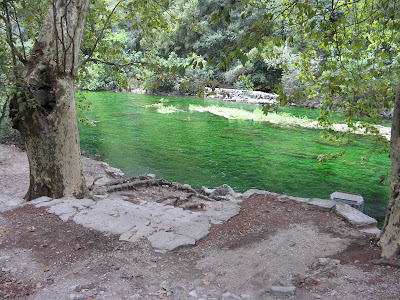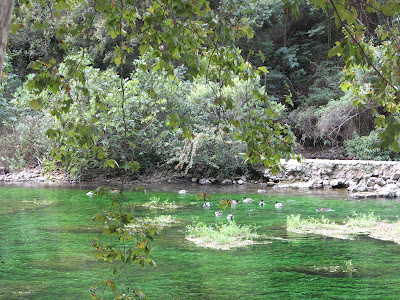Despite a forecast of thunderstorms and rain we headed off reasonably early. I had read that there was a charge for parking in Fontaine de Vaucluse but when we parked we could find no machine. There was a young woman about to drive off so I asked her where we paid for parking. She went into a lengthy explanation at a speed way beyond my comprehension. The gist of it was that the parking attendant had not arrived yet, it being before 10 am, and we were parked so "tant pis" for him. I might have looked a little uncertain and she patted me on the shoulder saying "Ne vous inquietez pas, Madame" (Don't worry). So we decided we wouldn't inquiete ourselves and off we went. We double-checked in the tourist office where the assistant said, " It's ok, tant mieux for you!". As we were leaving we fully understood the situation. The parking attendant takes his position at the entrance of the road leading to 3 car parks. From there he collects 3 euro 50 from every driver but he does not give a ticket. When you leave the car park, you take the opposite road and do not have to pass him. So, if you are parked before he takes up his post, then tant pis for him and tant mieux for you!
Fontaine de Vaucluse is a small medieval village tucked in a "closed valley" of the plateau de Vaucluse. I'm assuming that a "closed valley" is one totally surrounded by mountains as that is what it appears to me. Scenically it is spectacular and it is worthy of visiting even if it had not the source of the Sorgue river which surges up from an unfathomable depth to develop into a fully-fledged river.
 |
| a fascinating view of the rocks of the plateau that surround Fontaine de Vaucluse. |
 |
| More of the rocks/cliffs/mountain. |
 |
| And again! The sculpting works of erosion. |
 |
| A view as we made our way upwards to where the Sorgue surges forth. |
The water in the river is spectacularly green - emerald green. It can only be from the green weed that is growing on the river bed. It is totally clear.
The River Sorgues gushes forth from here. Oops, not today! A visitor like us, at this time of year, might be rather sceptical. However, we are aware that this is September and for the last three weeks we have seen no rain (until yesterday) and that is after the hottest and driest summer season the area has had in a long time.
 |
| The dry river bed over which the Sorgue should be seething and rushing. |
On our way up we had noticed that there were gushes of water from varying places lower down than the source so we came to the conclusion that the water table is lower and so the water escapes lower down. When the rainwater and melting snow on Mont Ventoux raise the level of the water, then the water comes surging out. There have been many attempts at diving to discover the mystery of the running and origin of its waters.
Long before speleologists ventured into the pool, it was made safe for them by Saint Veran who chased away the dragon that lived in the fountain's grotto. Most recently coloured dye has been used to prove that the source originates somewhere high up on the plateau de Vaucluse, flowing 20 - 30 kms through rocky underground passages before it arrives at the pool.
 |
| The water wheel at the paper mill. |
 |
| Water speeding towards the water wheel. |
The paper museum was really interesting and still produces some beautiful old-fashioned paper.
Since I've come to Provence, I've noticed that santons are something important. It has taken we quite a while to understand exactly what they are. They are small, hand-painted terracotta figurines (mainly nativity figurines and scenes but not always) produced in Provence. In a tradition Provencal creche (crib) there are 55 individual figures representing various characters from Provencal village life such as
the scissors grinder, the fishwife, the blind man and the chestnut seller. The creation of santons today is essentially a family craft, handed down from parents to children. We went into the Santon museum in Fontaine de Vaucluse to get an idea of what they are like. It was like stepping into a miniature world. I found them very interesting and thought there was a lot of humour in them
I gather that families build up their collection of santons for their Christmas crib, buying various figurines over the course of the years. I though that I would like to get a basic crib and went to one of the nearby shops - not a chance! They are very expensive!
Obviously a lot of work goes into making these. There was one in a walnut shell that took 240 hours to make and that had 59 figurines! We had to use a magnifying glass to see them properly.
 |
| Multi-arched 19th century Aqueduct de Galas. |
Our local pub owner had said that the food in L'Isle de la Sorgue was very good. I'm sure he was talking about quality restaurants but we were more interested in value and something that was French and tasty. So we went rambling about looking at the canal and the river and whatever buildings caught our eye. In the Middle Ages it was a true island among marshlands which were slowly drain by the construction of the canals.
It has become known as the Venice of the state. There was no sign of that but I'm sure that is reserved for the myriads of tourists in the summer. Anyway, we found a restaurant on the canal and enjoyed watching a little girl trying to feed the ducks by throwing full slices of baguette to the ducks who proceeded to violently fight for the bread. Eventually her father tore bits off the baguette pieces and the ducks were happier. At this stage a little Mistral was blowing resulting in all sorts of near calamities. At most of the restaurants the easels, advertising the plats du jour, fell over. The dogs tied to the easels set up an awful hue and cry looking for their oblivious masters. Across the road, at the restaurant next door to us, the huge pot with a tree fell over and almost caused a van to run into it. Things calmed down until we were ready to pay. Then we had a conversation with the waiter who needed to know how we would pay before we got the bill. We said "Card" and he was happy with that and made his way back into presumably to find a card machine. Then he returned with copious explanations - to be interrupted by the smashing of glasses caused by the wind overturning a chair and pulling the tablecloth off causing the glasses to shatter on the ground. He had to excuse himself to deal with the situation. When he returned he told us that his collegue had gone off with the keys of the cash machine and that we would have to wait to pay by card. Jim offered to pay by cash but that was also a problem because he would not have any change. I was wondering if anyone had simply walked off without paying in such circumstances - I know I was tempted. However, we had eaten well at reasonable prices and found the exact amount! No tip!
 |
| Two views of a monument in L'Isle de la Sorgue. |
 |
| L'Isle de la Sorgue is known for its antiques. |
 |
| Advertising antiques! |
 |
| A waterwheel with lots of moss. |
 |
| Cute arch over canal. |
A short distance out of L'Isle de la Sorgue is Partage des Eaux where the Sorgue, arriving from Fontaine de Vaucluse divides into two one river flowing one way and the other - the other way!
 |
| Ducks like it! |
 |
| Venasque from a distance. A perched village - one of the most beautiful in France. |
We spent quite a lot of time trying to find our way to Venasque from Carpentras (where we didn't want to go anyway!). Eventually, we had to nicely ask Nuvi, who has been feeling rather neglected over the last while, to guide us there. This she did, leading us to Venasque. On arrival we parked right beside the Church (I think it's Notre Dame de Venasque) and went out on foot. There is a very interesting picture of the Crucifixion there that spent a lot of time ignored, in fact hidden because of its lack of gilt, until someone realised its worth! We weren't allowed a photo.
 |
| All these are what we saw. The Baptistry is one of the oldest buildings in France. |
The journey home was continued over the D4 to Apt. This we did over a narrow, winding, hair-pin drive that had Jim muttering obscenities while I closed my ears and sometimes my eyes until we reached the more normal road from Apt to Lourmarin which, as a matter of interest, had elicited many obscenities on his first experience of it!
Finally we were back on familiar territory and I decided to take a picture of what I have found really strange - pumpkins growing in fields. I'm sure it's not strange to anyone from here!



































No comments:
Post a Comment